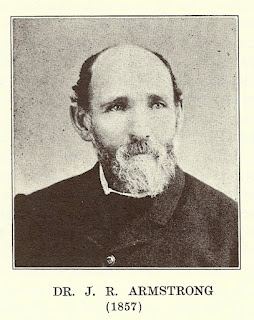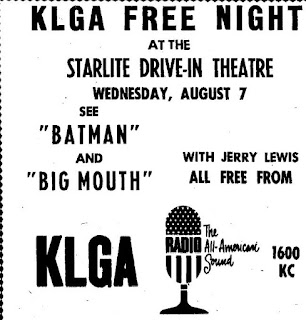Old
news clippings may be my Achilles heel.
When I come across a stack of them, I just can’t resist thumbing through
them in the hope that I will come across something that I haven’t seen before
or that sheds light on a subject that interests me. I happened upon one that did just that
recently. It was all about the Algona
Harp Orchestra. I had read about the
orchestra playing at the opening of the Durdall Hotel in 1900, but had no idea
of its history until this clipping came to light. It reignited the spark to find out more about
them.
 |
| Pat Cady, August Sterzbach, Fritz Granzow, Mart McCall and Joe Powers |
THE FORMATION OF THE ORCHESTRA
Although
it is not quite clear exactly when the Algona Harp Orchestra was organized, by
1896 it was managed by August Sterzbach.
By day Sterzbach was a butter maker at the Algona creamery, but was a
violinist with the group. The harp was
played by Mart McCall who was a registered pharmacist and worked at Ehlers Drug
Store. Other members included G. W. “Pat”
Cady on cornet, Fritz Granzow on clarinet and another unidentified member on
bass.
The
orchestra had a steady following. They had
to have an extensive repertoire of musical selections as they played at a wide variety
of occasions. The group played on a
traveling “circuit.” Travel was by train
and their circuit covered a large area.
In addition to Algona, they played at all of the smaller communities in
the county and cities outside the county as far away as Hampton and Ceylon,
Minnesota.
PERFORMING
No
occasion was too big or too small for the ensemble. They became a staple at
store openings or holiday
celebrations, special events such as the Chrysanthemum Show put on by the
W.C.T.U. each November, and private parties held in local homes. They played at the grand opening of the
Durdall Hotel in 1900. Each Thanksgiving
they would furnish the music for the grand military ball held at the armory
hall. The New Year’s Eve ball was also a
big community event each year at which they shared their music.
 |
| Algona Courier, October 15, 1909 |
Members
of the orchestra changed from time to time.
A violinist by the name of Joe Powers played with the group for a period
of time. He lived at the Durdall Hotel
and the orchestra would perform at Sunday dinners at the hotel to pay for his
room and board.
They
often played during various stage productions presented at the Call Opera
House. The entertainment at the theatre
would range from Shakesperian plays such as Othello
to comedies and the harp orchestra had to be able to play whatever music was necessary
for the occasion. When playing at the
Call, the group would sometimes expand to include one or more of the
following: John Scott, violin; Kate
Smith, violin; Oscar Johnson, violin; Charles Nicoulin, clarinet; Moore Smith,
cornet; Glen Brunson, Euphonium; Mr. Jones, cello; Mr. Kyle, French horn; Prof.
Benjamin, piano; and Frank Ostrum, drums.
 |
| Back: Hugh R. Smith, euphonium; and Mart McCall, harp Front: Moore Smith, cornet; John Scott violin; Chas. Nicoulin, clarinet Algona Advance, January 19, 1905 |
Dance
clubs were popular at the time and most communities formed one. The Algona version was called the Ideal Dance
Club and many well-known citizens were members.
They had regular gatherings, but on several occasions each year a very
special event was held. On one occasion
in February of 1904, the Algona Harp Orchestra was the musical entertainment at
a Ladies’ Masque Ball in honor of Valentine’s Day held in the ballroom of the Durdall
Hotel on the west end of State Street in Algona. The grand march began at 8:30 in the evening.
Over 100 people were in attendance, all clad in a variety of costumes. Spanish girls, Indian maidens, Little Red
Riding Hood, Japanese ladies, and the Queen of Spades were in attendance as
well as Uncle Sam, police officers, clowns and dominos. The crowd danced to the strains of the music offered
by the Algona Harp Orchestra in the beautifully decorated ballroom until the
unmasking at 10:30 p.m. A luncheon of
sandwiches, coffee, cake and ice cream followed. Many of the more notable names in the community
were members of the club – Mr. and Mrs. J. T. Chrischilles, Col. and Mrs.
Robert Spencer, Mr. and Mrs. W. C. Dewel, Dr. and Mrs. Sheetz, and many others.
Several
times a year the group would present a sacred concert at a local church, usually
the Congregational Church or the Methodist Church. Often they would join their talents with the
church choir and organ.
THE MUSIC ENDS
Members
came and went. Although the group
usually consisted of five musicians, at times it would be as few as three. The orchestra would reorganize several times
through the years and others who also shared their talents with the group were
Edith Bowyer Whiften, Charles Crammond, Hugh Smith, Glen Brunson and Durwood
Walker. By the early 1920s, the ensemble had disbanded for the last time and
the Algona Harp Orchestra was no more.
The
orchestra brought a lot of enjoyment to the area during its existence. From the most relaxed events such as a barn
dance to black tie affairs at the Call Opera House, the ensemble managed to
entertain audiences far and wide. As an
article published in the Algona Advance on January 19. 1905, stated, “The orchestra have a fine repertoire of music
and are constantly receiving all the late popular pieces as fast as they are
published. Our citizens are, and should
be, proud that Algona possesses a musical organization of such rare merit.”
Until
next time,
Jean
If you enjoyed this
post, please don’t forget to “like” and SHARE to Facebook. Not a Facebook
user? Sign up with your email address in the box on the right to have
each post sent directly to you.
Be sure to visit the
KCHB Facebook page for more interesting info about the history of Kossuth
County, Iowa.
Reminder: The posts on Kossuth County History Buff are ©2015-16 by
Jean Kramer. Please use the FB “share” feature instead of
cutting/pasting.










